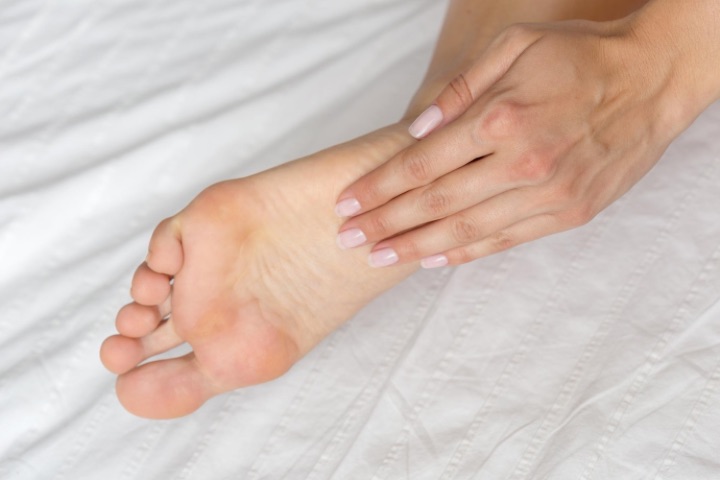Plantar fasciitis is a common foot condition that causes pain in the heel and bottom of your foot. It’s caused by inflammation of the plantar fascia, which is a thick band of tissue that connects your heel bone to your toes.
Symptoms include sharp pain when you first get up in the morning or after sitting for long periods, and dull, throbbing pain throughout the day. You may also experience swelling and tenderness in the affected area.
The good news is that there are several treatments available to help alleviate symptoms. Your doctor may recommend stretching exercises, orthotics, anti-inflammatory medications, physical therapy, or steroid injections. Surgery may sometimes be necessary if other treatments do not resolve the issue.
If you’re experiencing heel pain and tension in your foot, you may be suffering from plantar fasciitis.
Plantar fasciitis is a common musculoskeletal condition caused by inflammation of the plantar fascia, a thick band of tissue on the bottom of the foot that supports the arch.
Though there are many possible causes for this condition, two primary ones are heel pain and increased tension in the foot.
You may experience heel pain if you have plantar fasciitis. This pain can range from mild to severe, and is usually worse in the morning or after standing for a long period of time. The most common symptom of this condition is a stabbing sensation in the bottom of your foot near the heel.
Additionally, you may also feel:
Other symptoms like redness and warmth around your heel may occur as well. If you are experiencing any of these symptoms, contact a medical professional right away to discuss treatment options.
A variety of factors, such as overuse, injury, or lack of stretching can cause foot tension. It can also be a sign of plantar fasciitis, the most common cause of heel pain.

Photo Credit: karlyukav
When the foot is tense, it puts extra strain on the plantar fascia, leading to soreness and inflammation in your heel. If left untreated, this could lead to further complications down the line.
To reduce foot tension and prevent plantar fasciitis, keep your feet relaxed throughout the day, take regular breaks from standing or walking, and perform regular stretching exercises. Regularly massaging your feet with a foam roller or tennis ball can help ease any built-up tension in your muscles and tendons too.
Additionally, wearing supportive footwear that provides cushioning and arch support will help reduce stress on your heels. If foot tension continues despite trying these methods, it would be wise to seek medical advice for potential treatment options for plantar fasciitis.
You may be experiencing Plantar Fasciitis if you have intense heel pain or your foot feels stiff. This condition is caused by plantar fascia inflammation, a thick band of tissue running from the heel to the toes.
To better understand its symptoms and possible treatments, read more about this condition.
Heel pain is often an indication of plantar fasciitis. It’s known to cause a sharp, stabbing sensation that can be severe enough to limit everyday activities like walking or running.
Additionally, it may:
If left untreated, this condition can worsen and become excruciatingly painful. If you experience any of these symptoms, seeing your doctor for proper diagnosis and treatment is important.
Foot stiffness is a common symptom of many foot conditions and can be quite bothersome. It typically occurs in the morning when you wake up, or after being inactive for a long period of time – such as sitting at a desk all day.

Photo Credit: fabrikasimf
People with this condition often experience this type of stiffness, which can make it difficult to walk and perform daily activities. The condition can usually be treated with simple lifestyle changes, including stretching exercises and supportive shoes.
Additionally, massaging your feet helps reduce stiffness and improve mobility. If these measures don’t provide relief, consulting a doctor may be necessary to determine an appropriate course of treatment.
To diagnose plantar fasciitis, your doctor will likely ask you about your symptoms and examine your foot. Your doctor might also order an X-ray or MRI to rule out other potential causes of heel pain such as a stress fracture.
An accurate diagnosis is essential so that the correct treatment plan can be implemented. Here are some ways that doctors diagnose plantar fasciitis:
Accurately diagnosing plantar fasciitis helps ensure that the right treatment plan is developed to help relieve foot pain and improve mobility.
Once a diagnosis has been made, treating plantar fasciitis can be done in several ways.
Resting the foot is key, taking pressure off the affected area and reducing inflammation.
Ice therapy may also help, as cold compresses can numb pain and reduce swelling.
Additionally, stretching exercises are beneficial for loosening up tight muscles and tendons in the feet.
Over-the-counter nonsteroidal anti-inflammatory drugs (NSAIDs) like ibuprofen or naproxen can also provide relief from pain.

Photo Credit: Freepik
Orthotics are also a popular treatment option; these custom inserts provide cushioning and support to the arch of your foot while you’re walking or standing.
Physical therapy that focuses on strengthening the feet and ankles is another effective approach to dealing with plantar fasciitis.
To avoid developing plantar fasciitis, you should take preventive measures such as staying active, but not overdoing it. Wearing comfortable and supportive shoes is also important. Properly stretching and strengthening your feet can help as well.
Doing these things can help to prevent the development of plantar fasciitis.
In addition, when engaging in activities that involve prolonged standing or walking, taking frequent breaks is recommended. If you wear high heels often, try alternating them with other types of footwear to reduce stress on the feet.
When participating in physical activity, make sure to perform a proper warm-up and cool-down routine with adequate stretching exercises. Maintaining a healthy weight can also reduce the risk of developing plantar fasciitis.
It typically takes a few weeks to months for your plantar fasciitis to heal. You’ll have to stay patient and follow your doctor’s instructions for the best results.
Yes, exercise can be beneficial for plantar fasciitis. Stretching and strengthening the lower leg muscles can help reduce pain and inflammation. Regular physical activity also boosts circulation to speed up healing.
Yes, there are home remedies for plantar fasciitis. Stretching, icing your feet and massaging the area can help relieve pain. Wearing supportive shoes and inserts can also provide relief.
What type of shoes are best for plantar fasciitis? Look for ones with plenty of cushioning and arch support. Avoid high heels or flip-flops, which don’t provide enough support. Orthotics can also help provide extra comfort and stability.
Are there any long-term effects? If left untreated, you could experience chronic heel pain and decreased activity. You may also develop stiffness in your foot or calf muscles.